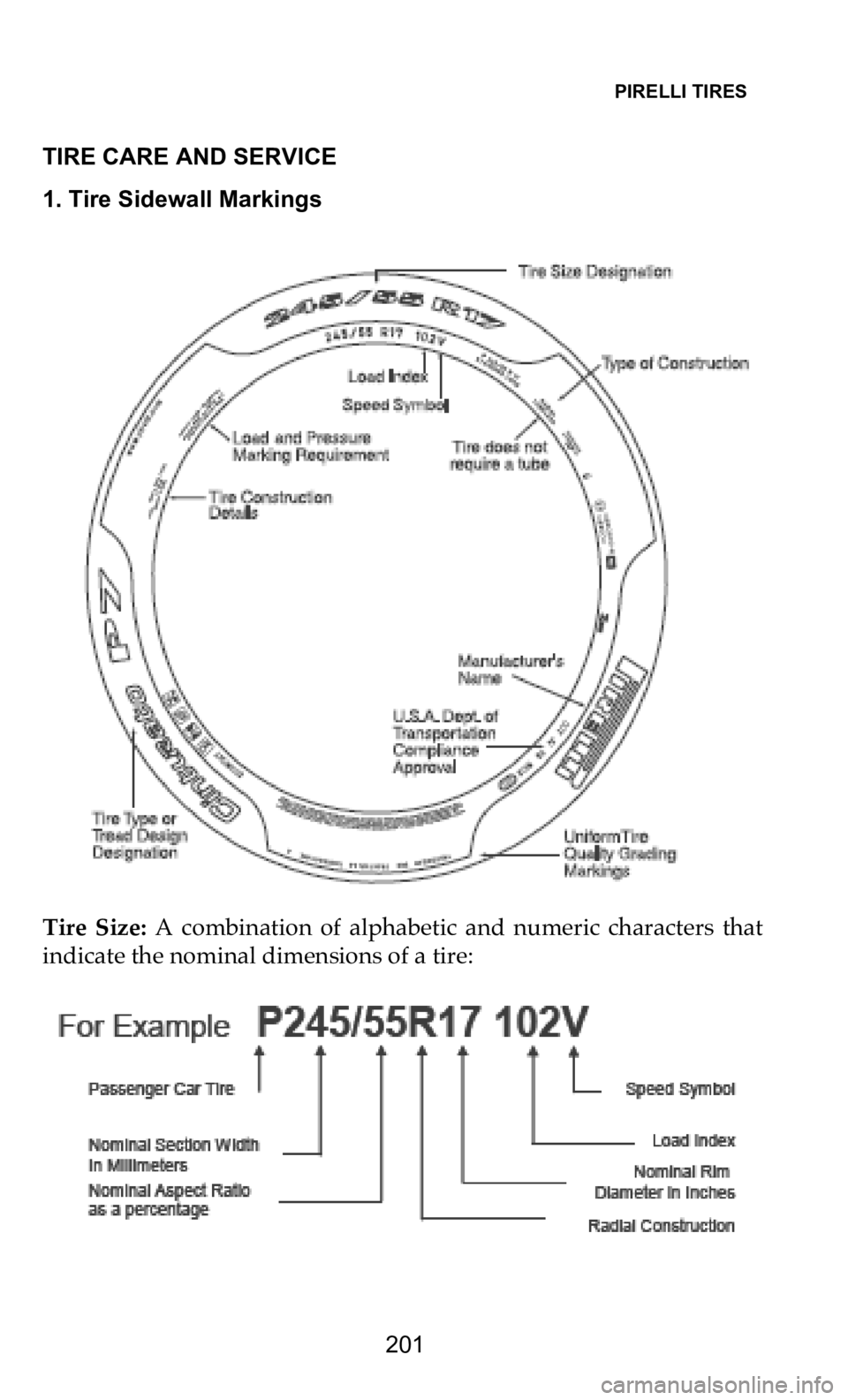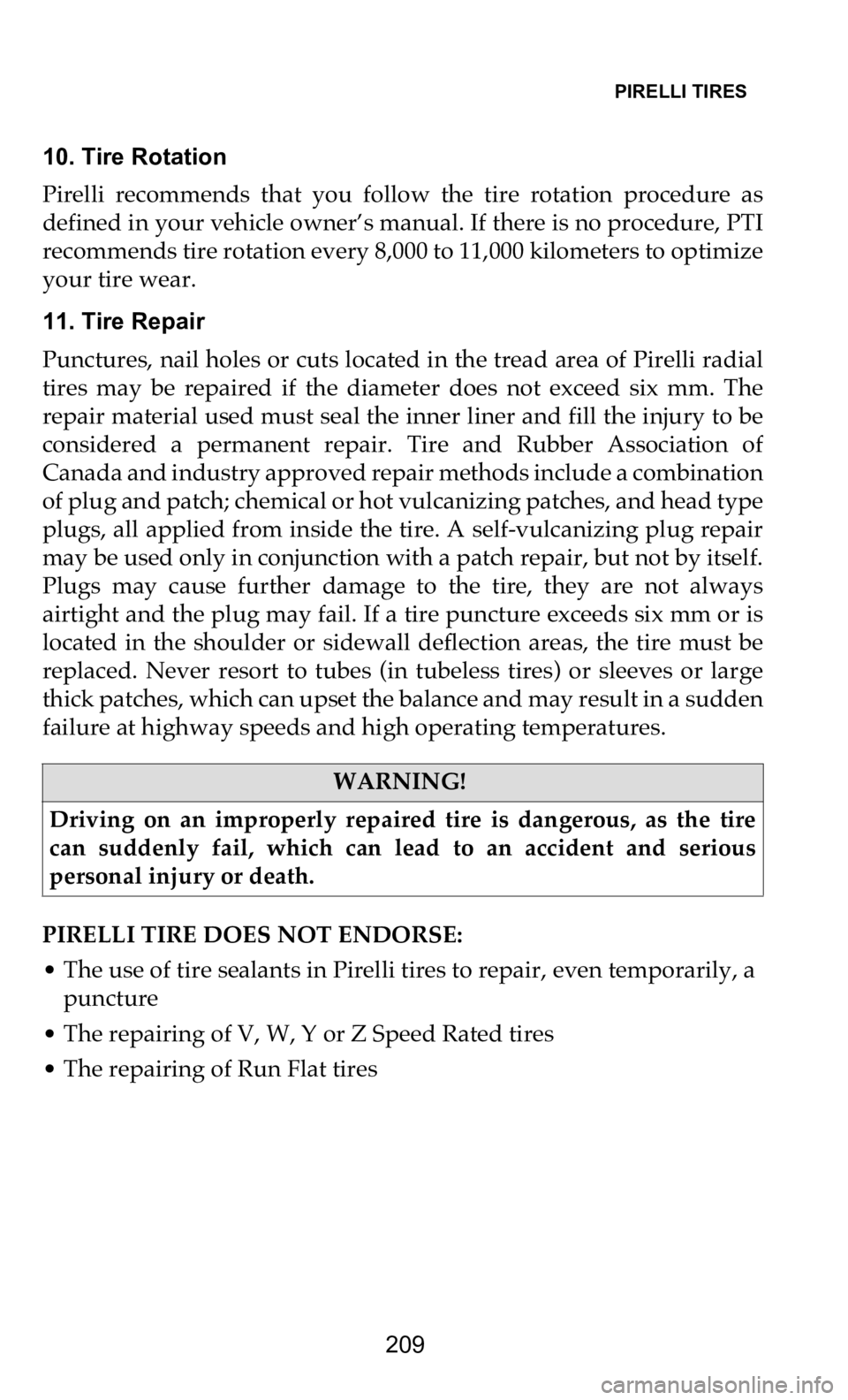DODGE DURANGO 2021 Vehicle Warranty
Manufacturer: DODGE, Model Year: 2021, Model line: DURANGO, Model: DODGE DURANGO 2021Pages: 262, PDF Size: 10.42 MB
Page 201 of 262

PIRELLI TIRES
200
REPLACEMENT PASSENGER CAR OR LIGHT TRUCK RADIAL
TIRE. ALL OTHER REMEDIES ARE EXCLUDED, INCLUDING ANY
OBLIGATION OR LIABILITY ON THE PART OF PTI FOR
CONSEQUENTIAL OR INCIDENTAL DAMAGES (SUCH AS A
LOSS OF USE OF VEHICLE, LOSS OF TIME OR INCONVENIENCE)
ARISING OUT OF AN ANOMALY.
Some provinces do not allow the exclusion or limitation of incidental
or
consequential damages, so the above exclusion may not apply to
you. This warranty gives you specific legal rights and you may also
have other rights which vary from province to province.
If further assistance or information is needed, please contact:
Consumer Affairs Group
Monday through Friday
8:00 AM to 6:00 PM Eastern Standard Time
Eastern Canada 1–
800–363–0583
Ontario 1–800–828–2585
W
estern Canada 1– 800–663–0148
Page 202 of 262

PIRELLI TIRES
201
TIRE CARE AND SERVICE
1. Tire Sidewall Markings
Tire Size: A combination of alphabetic and numeric characters that
i
ndicate the nominal dimensions of a tire:
Page 203 of 262

PIRELLI TIRES
202
Load Index: A numerical code indicating the maximum load carrying
capacity of a tire at the maximum cold inflation pressure.
LOAD MAXIMUM LOAD
PE R TIRE LOADMAXIMUM LOAD
PE R TIRE
INDEX KgLbsINDEX KgLbs
80 450 9921069502094
81 4621018 1079752149
82 4751047 1081000 2205
83 4871074 1091030 2271
84 500 1102 1101060 2337
85 515 1135 1111090 2403
86 530 1168 1121120 2469
87 5451201 1131150 2535
88 5601234 1141180 2601
89 5801278 1151215 2679
90 6001323 1161250 2756
91 6151356 1171285 2833
92 6301389 1181320 2910
93 6501433 1191360 2998
94 6701477 1201400 3087
95 6901521 1211450 3197
96 7101565 1221500 3307
97 7301609 1231550 3417
98 7501653 1241600 3528
99 7751708 1251650 3638
100 8081764
1261700 3748
101 8251819 1271750 3859
102 8501874 1281800 3969
103 8751919 1291850 4079
104 9001984 1301900 4190
105 9252039 1311950 4300
Page 204 of 262

PIRELLI TIRES
203
Speed Symbol: An alphabetic code indicating the maximum speed
at which the tire can carry a load corresponding to its Load Index
under specified service conditions.
*For tires having a maximum speed capability above 149 mph, a “ZR”
m a
y appear in the size designation; above 186 mph, a “ZR” must
ap
pear in the size designation, including a ”Y” speed symbol in
brackets.
Other Markings:
P - As part of the tire size designation (e.g., P205/65R15), is used to
in
dicate the tires intended for service on passenger cars.
LT - As part of the tire size designation (e.g. LT235/75R15), is used to
i
ndicate the tires are intended for service on light truck vehicles.
M&S - Letters used to indicate a tire suitable for Mud and Snow and/
o
r All Season usage.
XL - As part of the size designation (e.g. P235/75R16 XL), is used to
i
ndicate the tire can carry more load as the maximum inflation
pressure and load are greater than a standard load version. (Also
could be called REINFORCED).
SPEED SYMBOL MAXIMUM SPEED
KM/H MPH
L 120 74
M 130 80
N 140 86
P 150 93
Q 160 99
R 170 105
S 180 112
T 190 118
U 200 124
H 210 130
V 240 149
W 270 168
*ZR Y300 186
(Y) ABOVE 300 ABOVE 186
Page 205 of 262

PIRELLI TIRES
204
2. Tire Categories
ALL SEASON TIRES (ALL WEATHER TIRES): Tires that are designed
to
perform in a variety of road conditions in all seasons of the year. An
all season tire will carry “M+S”, “M&S”, or “M/S” designation on the
sidewall. All Season tires may carry a Limited Treadwear Warranty
depending on line.
SUMMER TIRES (MAXIMUM PERFORMANCE, HIGH
PE
RFORMANCE, ULTRA HIGH PERFORMANCE): Summer
Performance tires offer superior handling, grip and cornering ability
compared to standard tires. They are rated for operation at higher
speeds. Maximum Performance, High Performance and Ultra High
Performance categories each have different performance
characteristics, UTQG ratings and rate of wear depending on line.
Some lines may carry a limited treadwear warranty.
WINTER TIRES (SNOW TIRES): A winter tire is a tire with a tread
de
sign and compound made specifically for snowy and icy conditions
and is identified by M&S, M+S or M/S markings on the sidewalls.
Tires designed for use in severe snow conditions are further identified
with a pictograph of a mountain with a snowflake on the sidewalls
and must meet specific snow performance test requirements. Pirelli
Winter tires do not carry a mileage warranty.
The information provided above is an overview of tire types. Tread
pa
tterns and rubber compounds vary among the seasonal tire types
and provide varying performance characteristics and limitations
based on your individual needs and vehicle specifications. Summer
performance tires are different than winter and all season types. To
determine which Pirelli lines carry a Limited Treadwear Warranty,
please refer to The PTI Treadwear Mileage Warranty Conditions and
Mileage Warranty sections found in this document.
3. Pressure Recommendations
Recommended tire inflation pressures for your vehicle can be found
ei
ther on your vehicle’s tire placard or in your vehicle owner’s
manual. Correct pressures are related to load, speed and vehicle
handling and are vital for even braking, maximum traction and good
tire life. Under no circumstances should your tire’s cold inflation
pressure be less than that indicated on your vehicle’s tire placard or in
your vehicle owner’s manual or higher than the maximum cold
inflation pressure molded on to the tire’s sidewall. Under inflation
causes excessive flexing, deterioration of the tire and rapid wear of the
Page 206 of 262

PIRELLI TIRES
205
tread edges. Over inflation results in an uncomfortable ride, a reduced
area of tire contact with the road surface (i.e., smaller tire footprint),
higher susceptibility to impact damage and rapid wear on the tread
center.
Inflation pressure must be checked at least once a month and should
b e
checked only when the tire is cold or before it has been driven.
Driving even a short distance (1 kilometer or 2 to 3 minutes) causes
ti
res to heat up and the air pressure to increase approximately 4 psi. In
case it is necessary to adjust the air pressure in tires that have been
driven, the air pressure should be increased to a gauge reading of 4 psi
higher than the recommended cold inflation pressure.
For Example Only:
Check the cold inflation pressure on the tires, at least by the next day.
N e
ver reduce or “bleed” pressure from hot tires since your tires will
then be underinflated when they cool down. Always use a reliable
pressure gauge.
4. Ultra High Performance (UHP) Summer Tires
Rubber compounds formulated for ultra high performance summer
ti
res can lose flexibility and may develop random surface cracks at
cold temperatures. Therefore extra care should be used in handling
tires in this condition. These compounds are optimized for maximum
dry and wet performance in warm conditions. Special tread
compounds in these tires will have decreased performance, such as
lateral and braking traction, at temperatures below 7° C or when
driving on snow or ice. Therefore, it is recommended to install winter
tires in these conditions.
WARNING!
Driving on tires with improper inflation pressure is dangerous.
Th
ese situations can cause a tire failure, including tread/belt
separation, even at a later date, which could lead to an accident
and serious personal injury or death.
Gauge Reading of Hot Tire: 27 PSI
Recommended Cold Inflation Pressure: 26 PSI
Desired Gauge Reading of Hot Tire:26 PSI + 4 PSI = 30 PSI
Therefore: Add 3 PSI
Page 207 of 262

PIRELLI TIRES
206
5. DOT Street Legal Competition Tires
P Zero Trofeo and P Zero Corsa tire lines use special tire construction
an
d compounds to achieve their distinctive performance in dry
conditions. As a result of that, their performance in cold temperatures,
heavy rain or standing water will be decreased. Use extreme caution
and drive slowly on wet roads.
The minimum tread depth will be reached earlier than normal road
ti
res, resulting in reduced tread life.
6. Winter Tires
The standard Pirelli tires may be effective in light snow conditions.
Ho
wever, for winter use, you may wish to install winter tires. During
winter use, Pirelli strongly recommends the fitment of four winter
tires. Please check your vehicle owner’s manual concerning winter tire
size recommendation. If the winter tires have a lower speed rating
than the original equipment tires, vehicle handling may be affected,
and the vehicle maximum speed must be reduced to the winter tire
speed rating.
Pirelli requires
that studded tires be installed on all four positions.
Installing studded tires only on the drive positions of any vehicle,
including a front wheel drive vehicle, may cause adverse handling
characteristics.
7. Run Flat Tires
Always refer to the vehicle owners’ manual with respect to specific
sa
fety and operating information relating to the vehicle. Damaged
Run Flat tires or Run Flat tires that have experienced a loss of pressure
should immediately be replaced with another Run Flat tire of identical
size and Service Description (Load Index and Speed Symbol).
Run Flat tires have been developed based on the specifications of the
ve
hicles on which they are mounted. Accordingly, Run Flat tires
should only be mounted on vehicles specifically manufactured to
accommodate Run Flat tires.
Run Flat tires must be mounted in conjunction with a functional Tire
Pr
essure Monitoring System (TPMS).
The mounting of tires and installation of the TPMS should be carried
ou
t by a specialized dealer.
Page 208 of 262

PIRELLI TIRES
207
8. Tire Replacement
The tires fitted to your vehicle as original equipment were tested and
ap
proved by the vehicle manufacturer and the tire manufacturer and
take into account all aspects of the vehicle’s operation. Changes in the
tire size, type or construction should not be made without seeking
advice from the vehicle or tire manufacturer or an authorized Pirelli
dealer since unapproved tires on your vehicle could adversely affect
steering, handling, braking and traction. The tire information (tire
size, load index and speed symbol) as found on the vehicle placard or
in the owner’s manual should always be followed when replacing
tires.
It is strongly recommended that Pirelli tires be mounted in sets of four
w i
th the same tread type. Pirelli tires should not be mixed with other
tire brands. It is necessary to follow this procedure because different
tire constructions have different handling characteristics. Tires on the
same axle must be the same manufacturer, brand, tire size, load index,
speed rating and Pirelli part number.
When changing only two tires on a vehicle which is homogeneously fitted
(f
our tires of the same tire size), fit the new tires on the rear axle. This
applies to all vehicles regardless of their drive axle. (Front or Rear Drive).
On all wheel drive or four wheel drive vehicles the tires must always
be
replaced in sets of four.
When replacing tires on light truck vehicles, you should always follow
th
e vehicle manufacturer’s recommendations. Passenger and light
truck tires are not interchangeable, due to differences in their
pressures and load carrying capacity.
P-Metric and Euro-metric Interchangeability: Euro-metric (Example:
22
5/45R17) tires have a load index which is equal to or greater than
that of the same size P-metric (Example: P225/45R17) tire. Therefore,
they have the same or higher load carrying capacity at the maximum
rated inflation pressure. Always check with your tire dealer or Pirelli
Tire Consumer Affairs to be sure of the exact interchangeability to
maintain proper vehicle dynamics.
Please be aware that it is important that, before fitting the suggested
ti
res, the fitment is allowed by the technical specifications of the
vehicle, the vehicle manufacturer and the relevant homologations.
Pirelli Tire does not express any view as to the compatibility of the
wheel/tire combination with the technical specifications for the
chassis and vehicle.
Page 209 of 262

PIRELLI TIRES
208
TO MAINTAIN PROPER VEHICLE DYNAMICS AND LOAD
CARRYING CAPACITY, REPLACEMENT TIRES MUST ALWAYS
HAVE A LOAD INDEX AND SPEED SYMBOL EQUAL TO OR
GREATER THAN THOSE FITTED AS ORIGINAL EQUIPMENT.
When making plus size fitments, you should consult with the dealer
re
garding any suspension or braking system modifications which
may be recommended for the vehicle.
9. Tire Inspection
As a minimum, tires (including the spare tire) should be examined
an
d air pressure checked monthly and always prior to long trips. They
should also be examined if you strike any unusual object on the road.
Tires showing bulges, cracks, cuts, penetrations or uneven wear must
be dismounted and examined by an authorized Pirelli tire dealer and
replaced if necessary. Pirelli tires have treadwear indicators in the
tread grooves, which show up when the tread has worn to 2/32”
remaining. At this point, your tires must be replaced because they are
illegal and dangerous.
The mere passage of time (age) does not cause tires to deteriorate, but
ra
ther exposure to outside forces. Such outside forces can include, but
are not limited to: road hazards, punctures, improper repairs,
misalignment, under inflated operation, over inflated operation,
excessive heat caused by over deflected operation, excessive exposure
to ozone, improper storage conditions, etc. Tire companies can only
have an impact on a few of these exposures. Tire companies add
antiozinants and anti-oxidants (anti-degradation compounds) to
minimize degradation. Pirelli believes that since there is no way to
accurately predict what outside forces a tire will be exposed to there is
no scientifically supportable age limit that can be set for tires.
To avoid cosmetic damage, use a mild soap solution to clean sidewalls
a n
d rinse off with low-pressure tap water. Never apply cleaners or
dressings to enhance sidewall appearance to avoid removal of
antioxidants, which are intended to prevent ozone degradation. The
removal of anti-oxidants may degrade the rubber and can lead to
sidewall cracking. Use of high-pressure sprayers may cause sidewall
damage.
WARNING!
Driving on a damaged tire is dangerous, as the tire can suddenly
fa
il, which can lead to an accident and serious personal injury or
death.
Page 210 of 262

PIRELLI TIRES
209
10. Tire Rotation
Pirelli recommends that you follow the tire rotation procedure as
de
fined in your vehicle owner’s manual. If there is no procedure, PTI
recommends tire rotation every 8,000 to 11,000 kilometers to optimize
your tire wear.
11. Tire Repair
Punctures, nail holes or cuts located in the tread area of Pirelli radial
ti
res may be repaired if the diameter does not exceed six mm. The
repair material used must seal the inner liner and fill the injury to be
considered a permanent repair. Tire and Rubber Association of
Canada and industry approved repair methods include a combination
of plug and patch; chemical or hot vulcanizing patches, and head type
plugs, all applied from inside the tire. A self-vulcanizing plug repair
may be used only in conjunction with a patch repair, but not by itself.
Plugs may cause further damage to the tire, they are not always
airtight and the plug may fail. If a tire puncture exceeds six mm or is
located in the shoulder or sidewall deflection areas, the tire must be
replaced. Never resort to tubes (in tubeless tires) or sleeves or large
thick patches, which can upset the balance and may result in a sudden
failure at highway speeds and high operating temperatures.
PIRELLI TIRE DOES NOT ENDORSE:
• T he use of tire sealants in Pirelli tires to repair, even temporarily, a
p
uncture
• The repairing of V, W, Y or Z Speed Rated tires
•
The repairing of Run Flat tires
WARNING!
Driving on an improperly repaired tire is dangerous, as the tire
ca
n suddenly fail, which can lead to an accident and serious
personal injury or death.